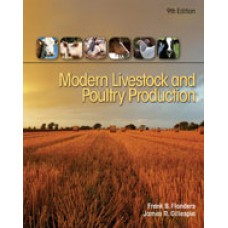This is completed downloadable of Solution Manual for Modern Livestock & Poultry Production, 9th Edition

Product Details:
- ISBN-10 : 1133283500
- ISBN-13 : 978-1133283508
- Author: Dr. Frank B. Flanders, James R. Gillespie
With coverage of basic animal science and livestock industry information as well as current issues in animal agriculture, the Ninth Edition of MODERN LIVESTOCK AND POULTRY PRODUCTION covers everything readers need to know about all phases and types of livestock production. Through updated visual aids, real-world applications, and comprehensive study tools, this engaging book provides readers with a solid understand of the anatomy, physiology, nutrition, feeding, and reproduction of multiple livestock and poultry breeds.
Table of Content:
- Contents
- Preface
- About the Authors
- Acknowledgments
- How to Use This Textbook
- Section 1: The Livestock Industry
- Ch 1: Domestication and Importance of Livestock
- Domestication of Animals
- Classification of Common Farm Animals
- Functions of Animals
- Consumption of Livestock Products
- Size and Scope of the Livestock Industry in the United States
- Animal Health Products
- Trends in Animal Agriculture
- Animal Welfare and Animal Rights
- Animal Identification
- Food Safety
- Endangered Species
- Summary
- Ch 2: Career Opportunities in Animal Science
- Employment in Agriculture
- Employment Opportunities for College Graduates in Agriculture
- Occupations in Animal Science
- Choosing an Occupation
- Sources of Information about Occupations
- On the Job: Employer Expectations and Good Work Habits
- Good Citizenship Skills
- Summary
- Ch 3: Safety in Livestock Production
- Types and Kinds of Injuries
- Human and Environmental Factors Relating to Safety
- Chemical Safety
- First Aid Kits
- Heat and Humidity Factors Relating to Safety
- Hazards in Handling Livestock
- Horse Safety
- Hazards of Animal Diseases
- Personal Protective Equipment
- Facilities
- Fire Safety
- Biosecurity and Agroterrorism
- Summary
- Ch 4: Livestock and the Environment
- Environmental Problems with Livestock Production
- Handling Livestock Wastes
- Environment and Nutrition
- Disposal of Dead Animals
- Livestock Laws
- Summary
- Section 2: Anatomy, Physiology, Feeding, and Nutrition
- Ch 5: Anatomy, Physiology, and Absorption of Nutrients
- Cells and Tissues
- Skeletal System
- Muscle System
- Respiratory System
- Circulatory System
- Integumentary System
- Immune System
- Nervous System
- Endocrine System
- Excretory System
- Reproductive System
- Digestive Systems
- The Digestive Process
- Development of the Ruminant Stomach
- Digestion in Poultry
- Absorption of Feed
- Metabolism
- Summary
- Ch 6: Feed Nutrients
- Energy Nutrients-Carbohydrates
- Energy Nutrients-Fats and Oils
- Proteins
- Vitamins
- Minerals
- Water
- Summary
- Ch 7: Feed Additives and Growth Promotants
- Kinds of Feed Additives and Hormones
- Beef Cattle
- Dairy Cattle
- Sheep and Goats
- Swine
- Poultry
- Horses
- Regulation of the Use of Additives
- Mixing and Residue Avoidance
- Keeping Records
- Health Concerns
- Summary
- Ch 8: Balancing Rations
- Classification of Feeds
- Ration Characteristics
- Ration Functions
- Balancing Rations
- Using Fixed Ingredients When Formulating Diets
- Substituting Silage for Hay
- Summary
- Section 3: Animal Breeding
- Ch 9: Genetics of Animal Breeding
- The Importance of Genetics
- Selection Based on Genetics
- The Cell and Cell Division
- Transmission of Characteristics
- Summary
- Ch 10: Animal Reproduction
- Reproduction
- Male Reproductive System
- Female Reproductive System
- Estrus Cycle
- Ovulation
- Fertilization
- Gestation
- Parturition
- Reproduction in Poultry
- Reproductive Failures
- Summary
- Ch 11: Biotechnology in Livestock Production
- Biotechnology
- Regulation and Safety in the Use of Biotechnology
- Cloning
- Genetic Engineering
- Bovine Somatotropin
- Paylean
- Genetic Engineering Research
- Opposition to Biotechnology
- Patents and Genetic Engineering
- Embryo Transfer
- Summary
- Ch 12: Animal Breeding Systems
- Systems of Breeding
- Summary
- Section 4: Beef Cattle
- Ch 13: Breeds of Beef Cattle
- Characteristics of the Beef Industry
- Development of Beef Breeds
- Selection of a Breed
- Characteristics of the Breeds
- Summary
- Ch 14: Selection and Judging of Beef Cattle
- Types of Beef Production
- Selection of Beef Animals
- Judging Beef Animals
- Summary
- Ch 15: Feeding and Management of the Cow-Calf Herd
- Integrated Resource Management
- Feeds
- Managing Feed Sources
- Feeding Dry, Pregnant Cows and Heifers
- Lactation Rations
- Creep Feeding of Calves
- Growing Replacement Heifers
- Growing, Feeding, and Care of Bulls
- Management of the Herd during Breeding Season
- Artificial Insemination
- Sex-Selected Semen
- Synchronization of Estrus
- When to Breed Heifers
- Calving
- Castration
- Dehorning
- Branding and Marking
- Managing Weaned Calves
- Preconditioning Calves
- Backgrounding Calves
- Summary
- Ch 16: Feeding and Management of Feeder Cattle
- Systems of Cattle Feeding
- Kinds of Cattle to Feed
- Buying Feeder Cattle
- Selection of Feeds
- Feeding Cattle
- Summary
- Ch 17: Diseases and Parasites of Beef Cattle
- Herd Health Plan
- Diseases
- External Parasites
- Internal Parasites
- Nutritional Health Problems
- Summary
- Ch 18: Beef Cattle Housing and Equipment
- Planning for Facilities and Equipment
- Cow Herd Facilities
- Feedlots
- Corrals
- Feeding Facilities
- Other Equipment
- Summary
- Ch 19: Marketing Beef Cattle
- Beef Checkoff and Promotion
- Supply and Demand
- Methods of Marketing
- Market Classes and Grades of Beef
- Handling Cattle Prior to and during Marketing
- Cattle Futures Market
- Summary
- Section 5: Swine
- Ch 20: Breeds of Swine
- Overview of the Swine Enterprise
- Selection of a Breed
- Characteristics of the Breeds
- Summary
- Ch 21: Selection and Judging of Swine
- Selection of Breeding Stock
- Selecting Feeder Pigs
- Judging Hogs
- Summary
- Ch 22: Feeding and Management of Swine
- Types of Swine Production
- Contracting in the Swine Industry
- Pork Quality Assurance Plus Program
- Reducing Nitrogen and Phosphorus Excretion
- Selecting Feeds for Swine
- Feeding the Breeding Herd
- Feeding Baby Pigs
- Feeding Growing-Finishing Pigs
- Preparation of Feeds
- Management Practices
- Feeder Pigs
- Summary
- Ch 23: Diseases and Parasites of Swine
- Disease and Parasite Prevention
- Infectious Diseases
- Nutritional Health Problems
- External Parasites
- Internal Parasites
- Other Health Problems
- Summary
- Ch 24: Swine Housing and Equipment
- Kinds of Buildings
- Site Selection and Building Placement
- Ventilation, Heating, and Insulation
- Floors
- Breeding Herd Facilities
- Gestation Facilities
- Farrowing Houses
- Growing Facilities
- Finishing Facilities
- Fencing
- Handling Equipment
- Feeding and Watering Equipment
- Summary
- Ch 25: Marketing Swine
- Pork Promotion
- Boar Meat
- Kinds of Markets
- Pricing Methods
- Market Classes and Grades
- Weight and Time to Sell
- Shrinkage of Hogs
- Futures Market and Hedging
- Summary
- Section 6: Sheep and Goats
- Ch 26: Breeds and Selection of Sheep
- Overview of the Sheep Enterprise
- Classes of Sheep
- Breeds of Sheep
- Selection of Sheep
- Judging Sheep
- Ch 27: Feeding, Management, and Housing of Sheep
- Systems of Raising Sheep
- Feeding of Sheep
- Other Management Practices
- Predator Loss
- Housing and Equipment
- Summary
- Ch 28: Breeds, Selection, Feeding, and Management of Goats
- Overview of the Goat Enterprise
- Classes of Goats
- Breeds of Goats
- Selection of Goats
- Meat Goat Evaluation
- Feeding Goats
- Management of Goats
- Housing and Equipment
- Protection from Predators
- Summary
- Ch 29: Diseases and Parasites of Sheep and Goats
- General Health Recommendations
- Diseases of Sheep and Goats
- Nutritional Problems
- External Parasites
- Internal Parasites
- Summary
- Ch 30: Marketing Sheep, Goats, Wool, and Mohair
- Marketing Sheep
- Marketing Wool
- Marketing Goats for Meat
- Marketing Goat Milk and Milk Products
- Marketing Cashmere and Mohair
- Summary
- Section 7: Horses
- Ch 31: Selection of Horses
- Horses in the United States
- Selection of Horses
- Breeds of Light Horses and Ponies
- Breeds of Draft Horses
- Unsoundness and Blemishes
- Vices
- Summary
- Ch 32: Feeding, Management, Housing, and Tack
- Feeds for Horses
- Feeding Horses
- Care of Broodmare and Foal
- Care of Teeth
- Foot Care
- Buildings for Horses
- Fences and Corrals
- Equipment for Feeding and Watering
- Horse Trailers
- Horse Tack
- Summary
- Ch 33: Diseases and Parasites of Horses
- Principles of Health Care
- Diseases and Disorders
- External Parasites
- Internal Parasites
- Summary
- Ch 34: Training and Horsemanship
- Understanding the Behavior of Horses
- Training the Young Horse
- Horsemanship
- Showing at Halter
- Equitation Classes
- Gymkhana
- Rodeos
- Trail Riding
- Summary
- Section 8: Poultry
- Ch 35: Selection of Poultry
- The Poultry Industry
- Breeds of Poultry
- Sources of Chickens
- Culling Chickens
- Sources of Turkeys
- Sources of Ducks
- Sources of Geese
- Summary
- Ch 36: Feeding, Management, Housing, and Equipment
- Feeding Poultry
- Managing Poultry
- Housing and Equipment
- Summary
- Ch 37: Diseases and Parasites of Poultry
- Maintaining Poultry Health
- Diseases and Disorders
- External Parasites
- Internal Parasites
- Summary
- Ch 38: Marketing Poultry and Eggs
- Price and Production Trends in Poultry and Eggs
- Marketing Poultry
- Classes of Ready-to-Cook Poultry
- Grades of Ready-to-Cook Poultry
- Marketing Eggs
- Classes and Grades of Eggs
- Summary
- Section 9: Dairy Cattle
- Ch 39: Breeds of Dairy Cattle
- Characteristics of the Dairy Enterprise
- Trends in Dairy Production
- Government Influence in Dairying
- The Purebred Dairy Cattle Association
- Breed Selection
- Characteristics of the Breeds of Dairy Cattle
- Summary
- Ch 40: Selecting and Judging Dairy Cattle
- Selecting Desirable Breeding and Production Animals
- Judging Dairy Animals
- General Description of the Scorecard
- Dairy Judging Terms
- Summary
- Ch 41: Feeding Dairy Cattle
- Methods of Feeding Dairy Cows
- Roughages for Dairy Cattle
- Grains for Dairy Cows
- Protein Supplements for Dairy Cows
- By-Products and Other Processed Feeds for Dairy Cattle
- Minerals for Dairy Cattle
- Vitamin Needs of Dairy Cattle
- Water Needs of Dairy Cattle
- Body Condition Score
- Feeding Lactating Dairy Cows
- Feeding Dry Cows
- Feeding Herd Replacements
- Balancing Rations for Dairy Cattle
- Feeding and Reproduction
- Feed Inventory
- On-Farm Feed Processing
- Summary
- Ch 42: Management of the Dairy Herd
- Records
- Dairy Herd Improvement Associations (DHIA)
- Identification of Dairy Animals
- Computers for Cow Identification and Management
- Standardizing Lactation Records
- Culling
- Goals for the Dairy Farm
- Budgets for the Dairy Farm
- Buy or Lease Dairy Cows
- Adjusting to Changes in the Economy
- Labor Management
- Managing Dry Cows
- Raising Dairy Replacements
- Hoof Trimming
- Maintaining Milk Production in Hot Weather
- Summary
- Ch 43: Milking Management
- Function of the Udder
- Recommended Milking Practices
- Milk Quality
- Cleaning and Sanitizing Milking Equipment
- Cooling Milk
- Preventing Chemical Contamination
- Preventing off Flavors in Milk
- Summary
- Ch 44: Dairy Herd Health
- Herd Health Plan
- Summary
- Ch 45: Dairy Housing and Equipment
- Planning the Dairy Facility
- Housing for the Milking Herd
- Milking in Stall Barns
- Milking Parlors
- Mechanization in the Milking Parlor
- Holding Area
- Milk House
- Bulk Tanks
- Stray Voltage
- Milking Equipment
- Housing for Dairy Herd Replacements
- Manure Handling
- Feed Handling
- Summary
- Ch 46: Marketing Milk
- Introduction
- Price of Milk
- Demand for Dairy Products
- Markets for Milk
- Hauling Milk to Market
- Milk Grades
- Federal Milk Marketing Order Program
- Dairy Imports and Exports
- Summary
- Section 10: Alternative Animals
- Ch 47: Rabbits
- Classification of Rabbits
- Uses of Rabbits
- Breeds
- Feeding
- Feeds
- Pelleting Feeds
- Storing Feeds
- Feeding Methods
- Diets for Commercial Production
- Maintenance Feeding
- Feeding Herd Bucks in Service
- Feeding Growing Junior Does and Bucks
- Feeding Pregnant and Nursing Does
- Rabbit Breeding
- Kindling
- Losses at Kindling
- Weaning
- Handling Rabbits
- Sexing Rabbits
- Identification of Breeding Rabbits
- Castration
- Care during Hot Weather
- Care during Cold Weather
- Maintaining Healthy Rabbits
- Common Health Problems
- Keeping Records
- Facilities and Equipment
- Marketing Rabbits
- Summary
- Ch 48: Bison, Ratites, Llamas, Alpacas, and Elk
- Bison
- Characteristics of the Bison Industry
- Management of Bison
- Feeding and Nutrition of Bison
- Bison Herd Health
- Facilities and Equipment for Bison
- Marketing Bison
- Ratites
- Llamas and Alpacas
- Elk
- Summary
- Appendix
- Glossary/Glossario
- Index
People Also Search:
modern livestock and poultry production 9th edition answer key
modern livestock and poultry production answer key
modern livestock and poultry production 9th edition





